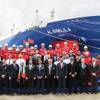Senior Central American and U.S. Coast Guard officials met in Panama Thursday to discuss the outcome of the first-ever 82-ft. Patrol Boat Round-Up that had been taking place at the old Rodman Naval Base near Panama City.
U.S. Coast Guard Vice Adm. James D. Hull, Commander Atlantic Area, Portsmouth, Va., as well as the coast guard commandants from Panama, Venezuela, Columbia, and Costa Rica discussed the maintenance, repairs and training that each patrol boat and its crew received during the PBRU, as well as the strong alliance and partnerships developed between the countries throughout the event.
“Although this (event) is primarily directed at maintenance, our goal is to do operations, either in conjunction or independently with the countries, and what we foster here between the individuals will last a long time,” said Hull during a press conference Thursday after touring some of the boats involved..
Over 150 crewmembers pulled into port in Panama during the middle of July, bringing ten Central American patrol boats, all once property of the U.S. Coast Guard but transferred to various nations after being replaced by newer 87-ft. patrol boats, all needing maintenance and repairs.
The crewmembers on U.S. Coast Guard Cutter Gentian, a 180-ft. sea-going buoy tender turned Caribbean Support Tender, conducted most of the training. The Gentian’s mission is to foster international cooperation and sustainable levels of operational readiness for regional maritime services.
A four-member team from Coast Guard’s Naval Engineering Support Unit (NESU), Portsmouth, Va., a four-member team from Coast Guard International Training Division, Yorktown, Va., and a two-member team from Coast Guard Maintenance and Logistics Command, Norfolk, Va., were also in Panama for the event.
Throughout the PBRU, crewmembers from the Gentian and the participating cutters assessed materiel condition and operational readiness of all the patrol boats involved, and made repairs as necessary on boat handling equipment, safety equipment, first aid kits, and law enforcement and boarding team equipment.
Crews also reviewed and provided training on preventive maintenance systems and procedures which will help improve operational proficiencies on engines, generators, small boats, boat handling equipment, damage control and firefighting gear, and command and control/navigation systems.
In addition to establishing coast guard capabilities of maritime services in the Central and South America, this type of event may ahve also assisted in promoting homeland security by helping reduce the need for U.S. presence in these waters.
“Ensuring these countries have viable law enforcement and security assets will hopefully reduce the demand for U.S. military presence in the area, thereby allowing U.S. services to focus on homeland security issues,” said U.S. Coast Guard Lt. Michael Barton, operations officer on the Gentian, homeported in Miami.
The patrol boats participating in the PBRU are the Albatros (PG33) and Pelicano (PG34), from Puerto Cabello, Venezuela, Cabo Corrientes (GC141) and Cabo Manglares (GC142) from Buenaventura, Columbia, Pancha Corrasco (SP-82-2) and Juan Rafael Mora (SP-82-3) from Golfito, Costa Rica, and the 12 de Noviembre (P-206), 28 de Noviembre (P-207, 4 de Noviembre (P-208) and 5 de Noviembre (P-209) from Colon, Panama.
The PBRU concluded Saturday with underway training of all the boats.
Subscribe for
Maritime Reporter E-News
Maritime Reporter E-News is the maritime industry's largest circulation and most authoritative ENews Service, delivered to your Email five times per week










